Themed collection Special issue in honour of Daoben Zhu

Professor Daoben Zhu: a giant in organic solids in China
Guest editors Qichun Zhang, Wenping Hu, Thuc-Quyen Nguyen, Qibing Pei and Jia Zhu introduce this Journal of Materials Chemistry C issue in honour of Professor Daoben Zhu on the occasion of his 80th birthday.

J. Mater. Chem. C, 2022,10, 2311-2313
https://doi.org/10.1039/D2TC90014A
Surface adhesion engineering for robust organic semiconductor devices
Strategies for enhancing interfacial adhesion of organic semiconductors by adhesive layer introduction, adhesive group functionalization, adhesive integrated agent, and physical mixing, have shown promising applications in various fields.

J. Mater. Chem. C, 2022,10, 2516-2526
https://doi.org/10.1039/D1TC05966A
Vertical organic transistors with short channels for multifunctional optoelectronic devices
For development of multifunctional smart devices, this perspective focuses on vertical transistors with short channels aided by nanotechnology.
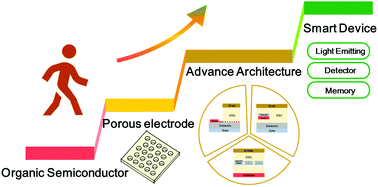
J. Mater. Chem. C, 2022,10, 2494-2506
https://doi.org/10.1039/D1TC05055A
The prospects of organic semiconductor single crystals for spintronic applications
Spintronic applications of OSSCs are discussed from the aspects of molecular structure, stacking structure, OSSC-based spintronic device fabrication, and multifunctional applications.

J. Mater. Chem. C, 2022,10, 2507-2515
https://doi.org/10.1039/D1TC04333A
Challenges and emerging opportunities in transistor-based ultrathin electronics: design and fabrication for healthcare applications
Recent issues toward ultrathin soft electronics are gradually focused on effective detection under complex environments. The promising strategies for long-term performance are summarized as a roadmap for design and fabrication.

J. Mater. Chem. C, 2022,10, 2450-2474
https://doi.org/10.1039/D1TC04384F
The effect of side chain engineering on conjugated polymers in organic electrochemical transistors for bioelectronic applications
The versatile synthetic side chain toolbox assists in tuning the OECT parameters by controlling material properties of organic mixed conductors. In this review we critically summarise and evaluate various side chains used throughout OECT materials.
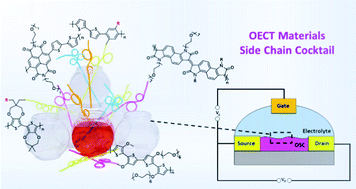
J. Mater. Chem. C, 2022,10, 2314-2332
https://doi.org/10.1039/D1TC05229B
Recent progress in pyrazinacenes containing nonbenzenoid rings: synthesis, properties and applications
This review focuses on the recent progress in the inclusion of a nonbenzenoid ring into the π-backbone of azaacenes, which can largely tune absorption, energy levels, and antiaromaticity, and produce exciting size-dependent properties.
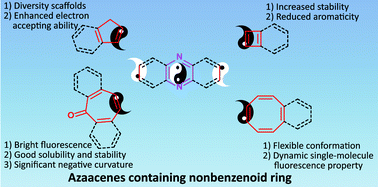
J. Mater. Chem. C, 2022,10, 2475-2493
https://doi.org/10.1039/D1TC04340D
Polycyclic aromatic hydrocarbon-based organic semiconductors: ring-closing synthesis and optoelectronic properties
Polycyclic aromatic hydrocarbons (PAHs) as a typical class of organic semiconductors demonstrate unique optical, electrical, magnetic and other interesting properties due to their extended conjugation and diverse structures.
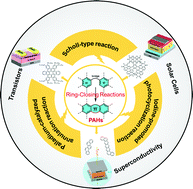
J. Mater. Chem. C, 2022,10, 2411-2430
https://doi.org/10.1039/D1TC04866J
Recent progress in open-shell organic conjugated materials and their aggregated states
In this review, we first summarize the general synthetic strategies towards stable open-shell organic conjugated materials, and then focus on their special aggregated states in OFETs, organic conductors, OLEDs and photoinduced radical materials.

J. Mater. Chem. C, 2022,10, 2431-2449
https://doi.org/10.1039/D1TC04598A
Methylamine gas healing of perovskite films: a short review and perspective
We summarize the internal chemical mechanism, crystallization kinetics and future prospects of the MA0 healing process.
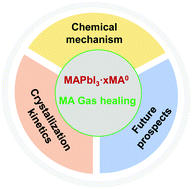
J. Mater. Chem. C, 2022,10, 2390-2399
https://doi.org/10.1039/D1TC04302A
Toward phosphorescent and delayed fluorescent carbon quantum dots for next-generation electroluminescent displays
Featuring a combination of size-tunable emission wavelengths, high thermal stability, and low cytotoxicity, carbon quantum dots (CQDs) have opened up a new possibility for next-generation displays.
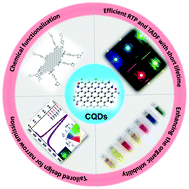
J. Mater. Chem. C, 2022,10, 2333-2348
https://doi.org/10.1039/D1TC04271H
Emerging materials for circularly polarized light detection
Detecting circularly polarized light is central to many advanced sensing technologies. We summarize the recent progress on the chiral materials developed for CPL detection and provide perspectives on strategies to improve the dissymmetry factors.

J. Mater. Chem. C, 2022,10, 2400-2410
https://doi.org/10.1039/D1TC04163K
Solid additives in organic solar cells: progress and perspectives
The use of solid additives in organic solar cells has drawn great attention owing to its great morphology-tuning ability. Here we review both organic and inorganic solid additives, which could provide useful guidance for the design of solid additives.
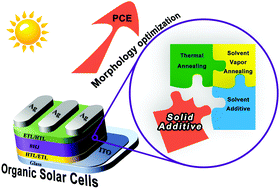
J. Mater. Chem. C, 2022,10, 2364-2374
https://doi.org/10.1039/D1TC04224F
Recent progress in single-molecule transistors: their designs, mechanisms and applications
Single-molecule field-effect transistors (FETs) are the key building blocks of electronic circuits and a unique platform for studying physical mechanisms. Here, the designs, mechanisms and applications of single-molecule FETs are summarized.
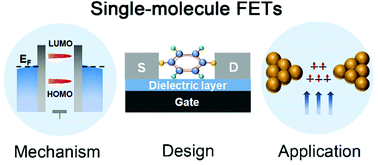
J. Mater. Chem. C, 2022,10, 2375-2389
https://doi.org/10.1039/D1TC04079K
Flexible transparent electrodes based on metallic micro–nano architectures for perovskite solar cells
This review summarizes recent progress in flexible transparent electrodes based on metallic micro–nano architectures, highlighting their applications in inverted, conventional and semi-transparent perovskite solar cells.
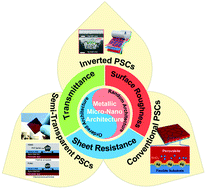
J. Mater. Chem. C, 2022,10, 2349-2363
https://doi.org/10.1039/D1TC04101K
Recent progress on organic exciplex materials with different donor–acceptor contacting modes for luminescent applications
In this review, beside the formation mechanism and emission process of exciplexes, we mainly discuss the donor–acceptor contacting modes and luminescence properties, which are important to develop high-performance and multifunctional optoelectronics.
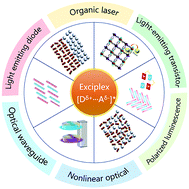
J. Mater. Chem. C, 2021,9, 16843-16858
https://doi.org/10.1039/D1TC04330G
Soft template-assisted self-assembly: a general strategy toward two-dimensional molecular crystals for high-performance organic field-effect transistors
A soft template-assisted self-assembly (STAS) strategy was developed to grow large-area high-quality 2D molecular crystals on a water surface irrespective of the surface tension of the solvents.

J. Mater. Chem. C, 2022,10, 2575-2580
https://doi.org/10.1039/D1TC04307B
Vacuum-deposited organic solar cells utilizing a low-bandgap non-fullerene acceptor
A new low-bandgap D–A type non-fullerene acceptor is designed and synthesized, which is successfully applied in full-vacuum-deposited organic solar cells and realizes a PCE of 0.86%.
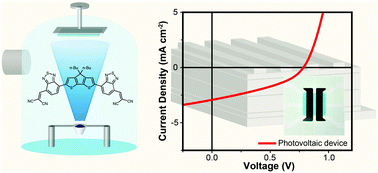
J. Mater. Chem. C, 2022,10, 2569-2574
https://doi.org/10.1039/D1TC03954G
Cocrystal engineering for constructing two-photon absorption materials by controllable intermolecular interactions
The intermolecular interactions of cocrystals can be controlled via selecting the donors and acceptors, and then the TPA properties can be selectively adjusted, promoting the development of TPA materials prepared via cocrystal engineering.
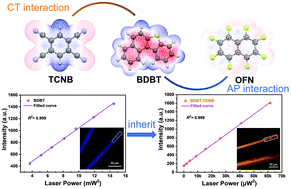
J. Mater. Chem. C, 2022,10, 2562-2568
https://doi.org/10.1039/D1TC04257B
A perylene diimide dimer-based electron transporting material with an A–D–A structure for efficient inverted perovskite solar cells
Through the combination of perylene diimide and triphenylamine moieties, a perovskite solar cell with DPT as the electronic transport material exhibited a PCE of 20.07%.
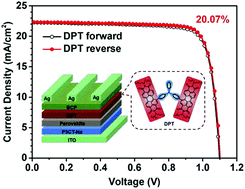
J. Mater. Chem. C, 2022,10, 2544-2550
https://doi.org/10.1039/D1TC04176B
Discovering structure–property relationships for the phonon band structures of hydrocarbon-based organic semiconductor crystals: the instructive case of acenes
A systematic analysis of the phonon bands calculated using dispersion-corrected density functional theory for crystalline acenes reveals analogies between the phonons and classical oscillator models. Based on these, the evolution of the materials’ properties can be rationalised.

J. Mater. Chem. C, 2022,10, 2532-2543
https://doi.org/10.1039/D1TC04708F
Single crystal field-effect transistor of tetrabenzoporphyrin with a one-dimensionally extended columnar packing motif exhibiting efficient charge transport properties
The single crystal field-effect transistor of 5,15-bis(triisopropylsilyl)ethynyltetrabenzoporphyrin exhibited better hole mobility than its metal complexes, with efficient charge transport through π–π stacking along tetrabenzoporphyrin units.
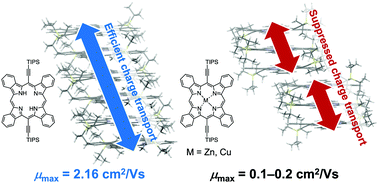
J. Mater. Chem. C, 2022,10, 2527-2531
https://doi.org/10.1039/D1TC03547A
Molecular design and crystallization process control for thin sheet-shaped organic semiconductor crystals with two-dimensional packing
A macroscopic morphology regulation from rod- to sheet-shaped crystals with the same single structure was realized via building a two-dimensional packed network in plane for organic semiconductors.

J. Mater. Chem. C, 2022,10, 2556-2561
https://doi.org/10.1039/D1TC03133C
Exciton funneling amplified photoluminescence anisotropy in organic radical-doped microcrystals
Controllable photoluminescence anisotropy amplification was achieved in organic luminescent radical-doped microcrystals via exciton funneling.
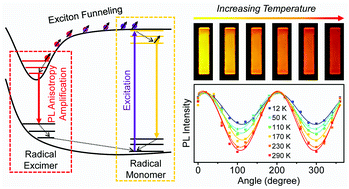
J. Mater. Chem. C, 2022,10, 2551-2555
https://doi.org/10.1039/D1TC02638K
Distinction of charge transfer and Frenkel excitons in pentacene traced via infrared spectroscopy
The vibrational anomalies of pentacene molecules have been investigated in conjunction with the high-energy excitonic features. Self-trapped excitons have been distinguished from the others.
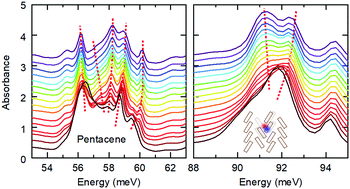
J. Mater. Chem. C, 2022,10, 5582-5589
https://doi.org/10.1039/D1TC04297A
Organic–inorganic hybrid metallic conductors based on bis(ethylenedithio)tetrathiafulvalene cations and antiferromagnetic oxalate-bridged copper(II) dinuclear anions
In (BEDT-TTF)3[Cu2(μ-C2O4)(C2O4)2(CH3OH)(H2O)], BEDT-TTF stacks in β′′ mode and shows metallic conductivity. Hydrogen bonds between antiferromagnetic oxalate-bridged binuclear anions form a square lattice. No long range order observed to 2 K.
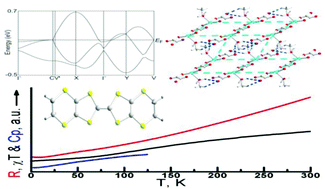
J. Mater. Chem. C, 2022,10, 2845-2852
https://doi.org/10.1039/D1TC04305F
Thionated PDI supramolecular polymers: controlling aggregation mechanisms, morphology and function
Thionation of a model perylene diimide has a significant impact on its self-assembly behaviour. This approach provides a facile route to simultaneously exert control over the mechanism, morphology and functionality of self-assembled PDI materials.

J. Mater. Chem. C, 2022,10, 2828-2837
https://doi.org/10.1039/D1TC04518K
Improving the charge injection in bottom contact organic transistors by carbon electrodes
An amorphous carbon film formed by a pyrolysis photoresist as the bottom contact source/drain electrode of OFETs to improve the charge injection as well as the device performance.
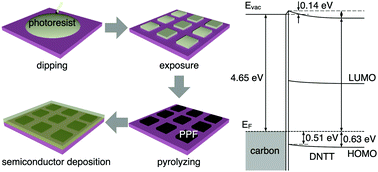
J. Mater. Chem. C, 2022,10, 2838-2844
https://doi.org/10.1039/D1TC05136A
A graphdiyne oxide composite membrane for active electrolyte enhanced supercapacitors with super long self-discharge time
GDYO/PVA self-assembled composite membrane as a separator effectively inhibited the self-discharge of AEESCs. The ultra-long self-discharge time is 37 160 s, and the capacitance retention rate is 95.1% after 8000 cycles.
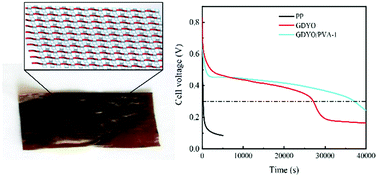
J. Mater. Chem. C, 2022,10, 2821-2827
https://doi.org/10.1039/D1TC04406K
Photopatternable solid electrolyte for integrable organic electrochemical transistors: operation and hysteresis
Entirely photopatternable solid organic electrochemical transistors were fabricated and their excellent performance and pronounced hysteretic behavior studied in detail.

J. Mater. Chem. C, 2022,10, 2656-2662
https://doi.org/10.1039/D1TC04230K
Crystalline organic thin films for crystalline OLEDs (I): orientation of phenanthroimidazole derivatives
Prepared by weak epitaxy growth, fluorescent phenanthroimidazole derivative 2FPPICz molecules form crystalline thin films. The orientation is resolved, providing a structure foundation for crystalline thin-film organic light-emitting diodes.

J. Mater. Chem. C, 2022,10, 2663-2670
https://doi.org/10.1039/D1TC04286F
New near-infrared absorbing conjugated electron donor–acceptor molecules with a fused tetrathiafulvalene–naphthalene diimide framework
New semiconducting D–A molecules with a fused tetrathiafulvalene–naphthalene diimide framework show near-infrared absorptions and emissions with maxima up to 1062 nm and quantum yields up to 1.64%.
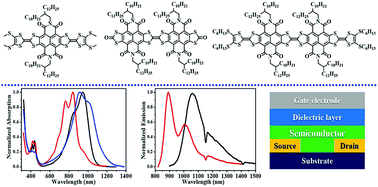
J. Mater. Chem. C, 2022,10, 2814-2820
https://doi.org/10.1039/D1TC04291B
A covalent organic polymer for turn-on fluorescence sensing of hydrazine
A polymer, COP-Ta, was designed and synthesized. It served as a turn-on fluorescent sensor for hydrazine detection with high performance.

J. Mater. Chem. C, 2022,10, 2807-2813
https://doi.org/10.1039/D1TC04335H
An asymmetric A–DA′D–π-A type non-fullerene acceptor for high-performance organic solar cells
Utilizing the symmetry-breaking and π-bridge-extending strategy, three non-fullerene acceptors with DA′D core unit and electron-withdrawing unit are designed and synthesized via changing the alkoxy-substituted thiophene bridge unit.

J. Mater. Chem. C, 2022,10, 2792-2799
https://doi.org/10.1039/D1TC04425G
Low nonradiative energy losses within 0.2 eV in efficient non-fullerene all-small-molecule organic solar cells
All-small-molecule organic solar cells with high photovoltaic performance and low non-radiative energy losses ≤ 0.2 eV.
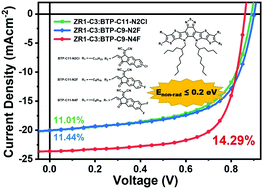
J. Mater. Chem. C, 2022,10, 2800-2806
https://doi.org/10.1039/D1TC04264E
Solution-processed broadband photodetectors without transparent conductive oxide electrodes
Room-temperature operated photodetectors without transparent conductive oxide electrodes by conjugated polymers mixed with conductive inorganic quantum dots, exhibiting the detectivities over 1012 Jones from 300 nm to 2000 nm, were demonstrated.
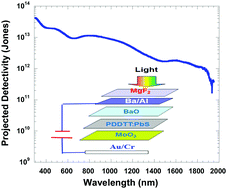
J. Mater. Chem. C, 2022,10, 2783-2791
https://doi.org/10.1039/D1TC04278E
Highly sensitive solid chemical sensor for veterinary drugs based on the synergism between hydrogen bonds and low-dimensional polymer networks
To realize the direct and prompt detection of solid veterinary drug additives (VDAs), we prepared a highly sensitive solid sensor based on the synergism between hydrogen bonds and low-dimensional polymer networks to enable a detection limit below 1 ppm.

J. Mater. Chem. C, 2022,10, 2648-2655
https://doi.org/10.1039/D1TC04114B
Efficient charge generation and low open circuit voltage loss enable a PCE of 10.3% in small molecule donor and polymer acceptor organic solar cells
Two small donors with alkyl chains close to (Se-1) and away from (Se-2) the donor core were synthesized. Ordered molecular packing and an induced face-on packing by PJ1 enable an efficient charge generation and low Voc loss in the Se-2/PJ1 device.

J. Mater. Chem. C, 2022,10, 2639-2647
https://doi.org/10.1039/D1TC04428A
The role of absorbed water in ionic liquid cellulosic electrolytes for ionic thermoelectrics
The absorbed water from air into cellulose/ionic liquid gel dramatically increases the apparent ionic Seebeck coefficient. The reason is the hydrovoltaic voltage that depends on the kinetics of water absorption/desorption at different temperature.
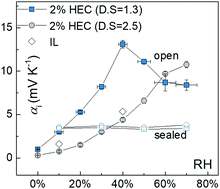
J. Mater. Chem. C, 2022,10, 2732-2741
https://doi.org/10.1039/D1TC04466D
A two-dimensional polymer memristor based on conformational changes with tunable resistive switching behaviours
A resistive switching memory device based on a 2DPTPAK+TAPB film with the conformational change mechanism was prepared and the memory behaviors can be adjusted by the degree of conformational changes.
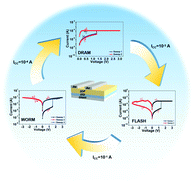
J. Mater. Chem. C, 2022,10, 2631-2638
https://doi.org/10.1039/D1TC04248C
Packing structures of (trialkylsilyl)ethynyl-substituted dinaphtho[2,3-b:2′,3′-f]thieno[3,2-b]thiophenes (DNTTs): effects of substituents on crystal structures and transport properties
Novel (trialkylsilyl)ethynyl-substituted DNTT derivatives are synthesized, and their crystal structures, transport properties, and the structure–property relationship are elucidated.
![Graphical abstract: Packing structures of (trialkylsilyl)ethynyl-substituted dinaphtho[2,3-b:2′,3′-f]thieno[3,2-b]thiophenes (DNTTs): effects of substituents on crystal structures and transport properties](/en/Image/Get?imageInfo.ImageType=GA&imageInfo.ImageIdentifier.ManuscriptID=D1TC04312A&imageInfo.ImageIdentifier.Year=2022)
J. Mater. Chem. C, 2022,10, 2775-2782
https://doi.org/10.1039/D1TC04312A
Improving the device performance of organic solar cells with immiscible solid additives
We developed a solid additive (uv-9) showing immiscibility with active layers for morphology control, a PCE of 17.18% was achieved, which is much higher than those of devices without any additives. Moreover, the generality of uv-9 has been verified.

J. Mater. Chem. C, 2022,10, 2749-2756
https://doi.org/10.1039/D1TC04222J
Surfactant-induced chirality transfer, amplification and inversion in a cucurbit[8]uril–viologen host–guest supramolecular system
The L4 molecular chirality can be amplified to a supramolecular scale by coassembling with SDS. Further incorporation of the CB[8] leads to a chirality inversion via a change from lamellar structure of L4/SDS to rectangular stacking in L4/SDS/CB[8].
![Graphical abstract: Surfactant-induced chirality transfer, amplification and inversion in a cucurbit[8]uril–viologen host–guest supramolecular system](/en/Image/Get?imageInfo.ImageType=GA&imageInfo.ImageIdentifier.ManuscriptID=D1TC03975J&imageInfo.ImageIdentifier.Year=2022)
J. Mater. Chem. C, 2022,10, 2763-2774
https://doi.org/10.1039/D1TC03975J
A tunable phosphorescence supramolecular switch by an anthracene photoreaction in aqueous solution
A supramolecular phosphorescent switch, composed of a linear assembly formed by a photosensitive bromophenylpyridium derivative and cucurbit[8]uril, can respond to the dual stimulation of ultraviolet light and heating with good reversible stability.
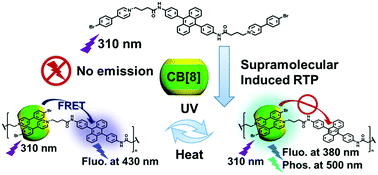
J. Mater. Chem. C, 2022,10, 2623-2630
https://doi.org/10.1039/D1TC04100B
A co-crystallization strategy toward high-performance n-type organic semiconductors through charge transport switching from p-type planar azaacene derivatives
The co-crystallization strategy has offered an efficient route to achieve high-performance n-type semiconductors through charge-transport switching from pristine p-type azaacene derivatives.

J. Mater. Chem. C, 2022,10, 2757-2762
https://doi.org/10.1039/D1TC04610A
Finely modulated asymmetric nonfullerene acceptors enabling simultaneously improved voltage and current for efficient organic solar cells
An asymmetric acceptor 5T-2C8-2Cl has been designed and an efficiency of 13.02% with simultaneously improved Jsc and Voc has been achieved.

J. Mater. Chem. C, 2022,10, 2742-2748
https://doi.org/10.1039/D1TC03793E
Diketopyrrolopyrrole-based conjugated polymers synthesized by direct arylation polycondensation for anisole-processed high mobility organic thin-film transistors
DPP-based conjugated polymers were synthesized via environmentally benign direct arylation polycondensation. With these polymers, OTFTs with μe values of up to 2.79 cm2 V−1 s−1 were fabricated using a green solvent anisole.
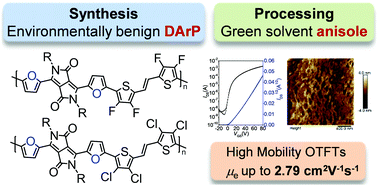
J. Mater. Chem. C, 2022,10, 2616-2622
https://doi.org/10.1039/D1TC04207F
Axially chiral bay-tetraarylated perylene bisimide dyes as non-fullerene acceptors in organic solar cells
Chromophore shielding is critical for twisted single core perylene bisimides used as non-fullerene acceptors in organic solar cells. Inherent chirality becomes only important for close packing chromophores as single crystal structure analyses reveal.
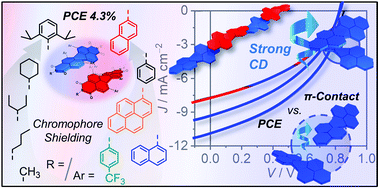
J. Mater. Chem. C, 2022,10, 2581-2591
https://doi.org/10.1039/D1TC04116A
An n-type narrow-bandgap organoboron polymer with quinoidal character synthesized by direct arylation polymerization
An n-type narrow-bandgap organoboron polymer with quinoidal character is synthesized by direct arylation polymerization. This polymer shows a narrow bandgap of 1.50 eV and could also be readily n-doped for thermoelectric applications.

J. Mater. Chem. C, 2022,10, 2718-2723
https://doi.org/10.1039/D1TC03421A
Molecular spinterface in F4TCNQ-doped polymer spin valves
An anionic radical through the charge transfer process of hybridization on the spinterface was found in a doped P3HT spin valve, which may effectively enhance the device performance.

J. Mater. Chem. C, 2022,10, 2608-2615
https://doi.org/10.1039/D1TC04259A
Doping of graphene via adlayer formation of electrochemically reduced dibenzyl viologen
Doping of graphene by self-assembled molecular network of uncharged dibenzyl viologen (DBV0) generated in situ.
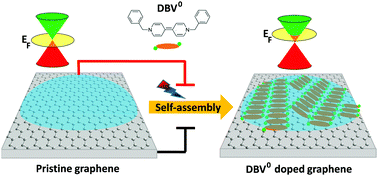
J. Mater. Chem. C, 2022,10, 2696-2702
https://doi.org/10.1039/D1TC03142B
Tuning the antiaromatic character and charge transport of pentalene-based antiaromatic compounds by substitution
Substituting electron-donating and electron-accepting substituents on antiaromatic pentalene cores can significantly tune the optical absorption, energy levels, antiaromaticity, and transistor switch-on behavior.
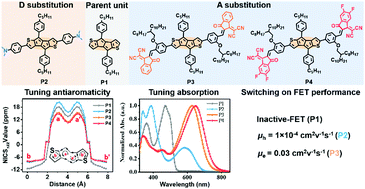
J. Mater. Chem. C, 2022,10, 2724-2731
https://doi.org/10.1039/D1TC03156B
Facile synthesis, precise species control and chemical transformation of highly conducting organic metal chalcogenides CuxBHT (BHT = benzenehexathiol; x = 3, 4, and 5.5)
A series of highly conducting organic metal chalcogenides CuxBHT (x = 3, 4, and 5.5) were precisely constructed via variation of the molar ratio of Cu2O and BHT, and a chemical transformation can be realized within the CuxBHT family by oxidation regulation.
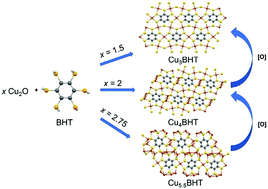
J. Mater. Chem. C, 2022,10, 2711-2717
https://doi.org/10.1039/D1TC03614A
A dithieno[3,2-a:3′,2′-j][5,6,11,12]chrysene diimide based polymer as an electron transport layer for efficient inverted perovskite solar cells
A series of electron-deficient conjugated polymers (P(DTCDI-T), P(DTCDI-2T) and P(DTCDI-3T)) are reported as effective ETLs for inverted PSCs, resulting in a champion power conversion efficiency (PCE) of 17.88% for P(DTCDI-2T) ETL based devices.
![Graphical abstract: A dithieno[3,2-a:3′,2′-j][5,6,11,12]chrysene diimide based polymer as an electron transport layer for efficient inverted perovskite solar cells](/en/Image/Get?imageInfo.ImageType=GA&imageInfo.ImageIdentifier.ManuscriptID=D1TC03942C&imageInfo.ImageIdentifier.Year=2022)
J. Mater. Chem. C, 2022,10, 2703-2710
https://doi.org/10.1039/D1TC03942C
A cationic conjugated polymer with high 808 nm NIR-triggered photothermal conversion for antibacterial treatment
A cationic water-soluble conjugated polymer with a D–A structure demonstrated high photothermal conversion efficiency and effective antibacterial ability under 808 nm irradiation.

J. Mater. Chem. C, 2022,10, 2600-2607
https://doi.org/10.1039/D1TC03128G
Regulating the metal nodes of 1D conjugated coordination polymers for enhancing the performance of sodium-ion batteries
1D conjugated coordination polymers M-DHBQ (M = Mn, Zn, and Ni) were constructed for sodium-ion batteries. Ni-DHBQ delivered the highest performance. These results highlighted the importance of metal ions for high performance batteries.

J. Mater. Chem. C, 2022,10, 2592-2599
https://doi.org/10.1039/D1TC03709A
Self-assembled dipoles of o-carborane on gate oxide tuning charge carriers in organic field effect transistors
A novel self-assembled monolayer of o-carborane on gate oxide not only realized p-channel organic field effect transistors with low threshold voltage and high field effect mobility, but also enabled ambipolar charge transport in a typical n-type organic semiconductor.

J. Mater. Chem. C, 2022,10, 2690-2695
https://doi.org/10.1039/D1TC02810C
Tunable charge-transport polarity in thienothiophene–bisoxoindolinylidene-benzodifurandione copolymers for high-performance field-effect transistors
The substituent effects in methyl- and methoxy-substituted thienothiophene–bis(oxoindolinylidene)benzodifurandione copolymers on field-effect performances were studied.

J. Mater. Chem. C, 2022,10, 2671-2680
https://doi.org/10.1039/D1TC02833B
Controllable growth of centimeter-scale 2D crystalline conjugated polymers for photonic synaptic transistors
Photonic synaptic transistors based on space-confined-drop-casting-produced 2D crystals of conjugated polymers perform typical synaptic functions.
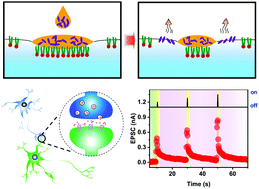
J. Mater. Chem. C, 2022,10, 2681-2689
https://doi.org/10.1039/D1TC02284A
About this collection
We are pleased to introduce you to this collection of invited articles from Journal of Materials Chemistry C in honour of Prof. Daoben Zhu, on the occasion of his 80th Birthday.
This special collection of Journal of Materials Chemistry C is a tribute to one of the pioneers of organic solids in China. As one of the pioneers of modern organic materials, Prof. Zhu has a close association with the community of organic conjugated materials. It is our great honour to invite a number of Prof Zhu’s former students, co-workers and friends to contribute some of their best work to this special issue and make this special Issue an exciting scientific reading. This special issue will cover all aspects of organic semiconductors including synthesis and theoretical investigation as well as their properties or applications related to display technologies, optical materials, magnetics, electronics or information storage technology.
We hope you enjoy reading this collection of papers in Journal of Materials Chemistry C in honour of Prof. Daoben Zhu.